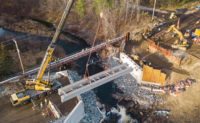
Equipment is becoming more complex and expensive, and competitive pressures make it essential to get every cent of value out of an equipment investment. The key is to adopt strategies to get a handle on the growing tide of complexity and cost.
One approach is to play defense: minimize initial costs as much as possible, reduce operating costs by cutting maintenance to the minimum, repair only if unavoidable and sell units before costs start to pile up. This strategy is based on the belief that a company can live off the quality built into the machine at the start and keep going when the company's fleet is turned regularly and quickly. With the right machines—and under the right conditions—it is possible to produce good results.
It does, however, become an absolute disaster when investment priorities force a slowdown in the replacement cycle. A company simply cannot select, operate and maintain for the short haul and then expect to operate and keep for the long haul.
The good news is that modern machines are getting better. Design, metallurgy, machining, lubrication and assembly are improving. Sensors, telematics and machine-control systems make it possible for machines to protect themselves and "speak" to us. We must change our policies, mind-sets and procedures to maximize the longer lives now built into the quality products available and benefit from the improvements made by manufacturers. I grew up thinking 10,000 hours was all you could get; my sons think in terms of 15,000 to 20,000 hours, and my grandsons will think in terms of 30,000 to 40,000 hours as a good first life.
Extending life and putting yourself in a position to amortize increased acquisition costs is a proposition only under two conditions: First, the rate of growth in repair parts and labor costs per hour must be managed and reduced as far as possible so that increasing the ownership hours does not cause the total life-cycle costs to escalate. Second, superior maintenance practices must make it possible for older units to achieve expected reliability and availability standards.
Furthermore, the following steps can help equipment owners extend life—without lowering reliability and availability.
• Select a machine that is capable of performing the required work. Nothing shortens life as much as overapplication. A company should know its requirements and size the equipment appropriately. If the machine is specified and selected correctly, it will benefit the company; if the wrong machine is chosen, the company will struggle throughout the life of the machine.
• Select a machine that is designed and built for the long haul. Not all machines are designed and created equally. A sturdy, long-life frame with a clear focus on component replacement is the key to a long and economical life. So, too, are simple things such as switches, electrical systems and electronics. Remember, dealer support is more important in later years, when the repair-rebuild-replace decision becomes critical.
• Look for technologies that maximize operator performance and enable the machine to protect itself and speak to you. After application, nothing has a greater impact on the machine's life than operator performance. Make sure the machine supports operator performance and has the load-sensing, diagnostics and telematics technologies needed to be proactive when it comes to maintenance and repair.
• Look for design features that ensure the fluids—air, fuel, oil and perhaps others—used by the machine are filtered and protected to the maximum extent possible. Dirt is a machines’ biggest enemy. Look to ensure that tanks and compartments are protected to the maximum extent possible, fillers and breathers are properly placed, and filtration systems have the capacity to exceed cleanliness requirements.
• Do not forget to upgrade and update your company's condition-based and preventive maintenance technologies to match the demands of today's high-performance equipment. The old lube truck with exposed reels, tanks and drums just will not cut it anymore. Understand the maintenance demands of new high-performance machines. Make sure your company has the field capability needed to maintain and extend the life of your company's new, very expensive and very productive equipment. You cannot maintain new generation equipment with old generation facilities.
Mike Vorster is president of CEMPCentral Inc., author of the book "Construction Equipment Economics" and a retired professor of construction engineering and management at Virginia Tech. Regularly serving as a fleet management consultant to leading companies, Vorster can be reached at mikev@cempcentral.com.




Post a comment to this article
Report Abusive Comment